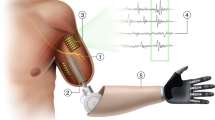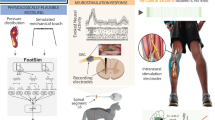Abstract
Neural prostheses have the potential to improve the quality of life of individuals with paralysis by directly mapping neural activity to limb- and computer-control signals. We translated a neural prosthetic system previously developed in animal model studies for use by two individuals with amyotrophic lateral sclerosis who had intracortical microelectrode arrays placed in motor cortex. Measured more than 1 year after implant, the neural cursor-control system showed the highest published performance achieved by a person to date, more than double that of previous pilot clinical trial participants.
This is a preview of subscription content, access via your institution
Access options
Subscribe to this journal
Receive 12 print issues and online access
$209.00 per year
only $17.42 per issue
Buy this article
- Purchase on Springer Link
- Instant access to full article PDF
Prices may be subject to local taxes which are calculated during checkout


Similar content being viewed by others
References
Hochberg, L.R. et al. Nature 485, 372–375 (2012).
Hochberg, L.R. et al. Nature 442, 164–171 (2006).
Collinger, J.L. et al. Lancet 381, 557–564 (2013).
Aflalo, T. et al. Science 348, 906–910 (2015).
Wolpaw, J.R. & McFarland, D.J. Proc. Natl. Acad. Sci. USA 101, 17849–17854 (2004).
Wang, W. et al. PLoS ONE 8, e55344 (2013).
Serruya, M.D., Hatsopoulos, N.G., Paninski, L., Fellows, M.R. & Donoghue, J.P. Nature 416, 141–142 (2002).
Velliste, M., Perel, S., Spalding, M.C., Whitford, A.S. & Schwartz, A.B. Nature 453, 1098–1101 (2008).
Taylor, D.M., Tillery, S.I. & Schwartz, A.B. Science 296, 1829–1832 (2002).
Carmena, J.M. et al. PLoS Biol. 1, e42 (2003).
Ganguly, K. & Carmena, J.M. PLoS Biol. 7, e1000153 (2009).
Suminski, A.J., Tkach, D.C., Fagg, A.H. & Hatsopoulos, N.G. J. Neurosci. 30, 16777–16787 (2010).
Mulliken, G.H., Musallam, S. & Andersen, R.A. J. Neurosci. 28, 12913–12926 (2008).
Bensmaia, S.J. & Miller, L.E. Nat. Rev. Neurosci. 15, 313–325 (2014).
Gilja, V. et al. Nat. Neurosci. 15, 1752–1757 (2012).
Sussillo, D. et al. J. Neural Eng. 9, 026027 (2012).
Simeral, J.D., Kim, S.P., Black, M.J., Donoghue, J.P. & Hochberg, L.R. J. Neural Eng. 8, 025027 (2011).
Cunningham, J.P. et al. J. Neurophysiol. 105, 1932–1949 (2011).
Perge, J.A. et al. J. Neural Eng. 11, 046007 (2014).
Quian Quiroga, R. J. Neurosci. Methods 177, 194–198 (2009).
Masse, N.Y. et al. J. Neurosci. Methods 236, 58–67 (2014).
Fraser, G.W., Chase, S.M., Whitford, A. & Schwartz, A.B. J. Neural Eng. 6, 055004 (2009).
Christie, B.P. et al. J. Neural Eng. 12, 016009 (2015).
Bacher, D. et al. Neurorehabil. Neural Repair 29, 462–471 (2015).
Ward, D.J. & MacKay, D.J. Nature 418, 838 (2002).
Kim, S.P., Simeral, J.D., Hochberg, L.R., Donoghue, J.P. & Black, M.J. J. Neural Eng. 5, 455–476 (2008).
Jarosiewicz, B. et al. J. Neural Eng. 10, 046012 (2013).
Kim, S.-P. et al. IEEE Trans. Neural Syst. Rehabil. Eng. 19, 193–203 (2011).
Pelli, D.G. Spat. Vis. 10, 437–442 (1997).
Brainard, D.H. Spat. Vis. 10, 433–436 (1997).
Chestek, C.A. et al. J. Neural Eng. 10, 026002 (2013).
Acknowledgements
The authors would like to thank participants T6, T7, S3 and their families; E.N. Eskandar for participant T7's implantation surgery; B. Davis, B. Pedrick, M. Coburn, B. Travers and D. Rosler for administrative support; S.I. Ryu for surgical assistance; L. Barefoot, P. Gigante, A. Sachs, S. Cash, J. Menon and S. Mernoff for clinical assistance; K. Newell for data collection assistance; J. Saab and N. Schmansky for technical assistance; and J.P. Donoghue for helpful scientific discussions. This work was supported by the Stanford Institute for Neuro-Innovation and Translational Neuroscience; Stanford BioX-NeuroVentures; the Stanford Office of Postdoctoral Affairs; the Garlick Foundation; the Craig H. Neilsen Foundation; The US National Institutes of Health: the National Institute on Deafness and Other Communication Disorders (NIDCD) (R01DC009899, principal investigator (PI): L.R.H.; R01DC014034, PI: J.M.H.), the National Institute of Neurological Disorders and Stroke (NINDS) (RO1NS066311-S1, PI: K.V.S.), the Eunice Kennedy Shriver National Institute of Child Health and Human Development (NICHD)-National Center for Medical Rehabilitation Research (NCMRR) (N01HD53403 and N01HD10018, Sub-award PI: L.R.H.); the Rehabilitation Research and Development Service, Department of Veterans Affairs (B6453R and B6310N, PI: L.R.H.); and the Massachusetts General Hospital (MGH)-Deane Institute for Integrated Research on Atrial Fibrillation and Stroke. The content of this paper is solely the responsibility of the authors and does not necessarily represent the official views of the US National Institutes of Health, the Department of Veterans Affairs or the United States Government.
Author information
Authors and Affiliations
Contributions
V.G. and C.P. were responsible for study design, further guided by K.V.S., J.M.H. and L.R.H. V.G. and C.P. were responsible for research infrastructure development, data collection, analysis, algorithm design and manuscript preparation. All authors contributed to the manuscript. P.N. and B.J. contributed to infrastructure development and algorithm design. C.H.B. and B.L.S. contributed to the data collection effort from study participants T6 and T7, respectively. C.H.B. participated in study design. A.A.S. and J.D.S. contributed to infrastructure development. J.D.S. provided data from subject S3. J.A.P. and B.J. conducted offline analyses to inform algorithm design. J.M.H. was responsible for surgical implantation for study participant T6. L.R.H. is the sponsor-investigator of the multi-site pilot clinical trial. J.M.H. and K.V.S. were involved in all aspects of the study.
Corresponding author
Ethics declarations
Competing interests
This work relates to patent US 8792976.
Supplementary information
Supplementary Text and Figures
Supplementary Tables 1–5 & Supplementary Figures 1–8 (PDF 2693 kb)
Rights and permissions
About this article
Cite this article
Gilja, V., Pandarinath, C., Blabe, C. et al. Clinical translation of a high-performance neural prosthesis. Nat Med 21, 1142–1145 (2015). https://doi.org/10.1038/nm.3953
Received:
Accepted:
Published:
Issue Date:
DOI: https://doi.org/10.1038/nm.3953
This article is cited by
-
Brain control of bimanual movement enabled by recurrent neural networks
Scientific Reports (2024)
-
Machine learning-based high-frequency neuronal spike reconstruction from low-frequency and low-sampling-rate recordings
Nature Communications (2024)



